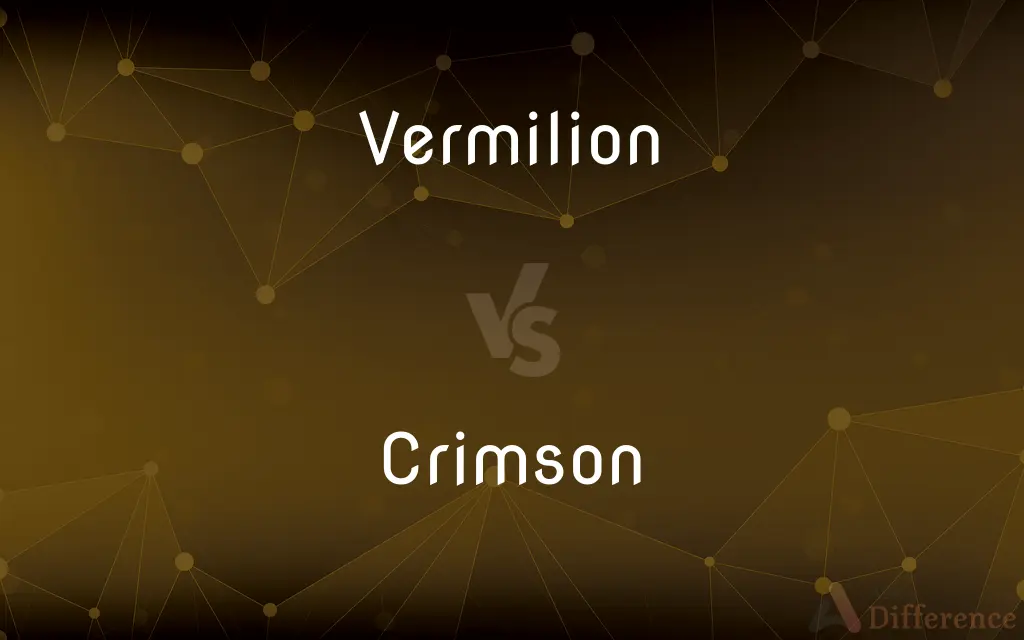Vermilion vs. Crimson — What's the Difference?
By Urooj Arif & Fiza Rafique — Updated on March 27, 2024
Vermilion is a brilliant red or scarlet pigment, originally made from cinnabar. Crimson, however, is a deep, rich red color with a slight purplish hue.

Difference Between Vermilion and Crimson
Table of Contents
ADVERTISEMENT
Key Differences
Vermilion is known for its bright and vivid red hue, traditionally obtained from the powdered mineral cinnabar. Its color is bold and leans towards orange-red under the spectrum of red colors. Whereas, crimson carries a deeper, more saturated red, with a subtle purplish undertone, making it appear richer and more velvety than vermilion.
In terms of historical and cultural significance, vermilion has been prized since ancient times for its striking color and was often used in art and decoration. On the other hand, crimson has been associated with nobility, power, and the Church, symbolizing wealth, status, and sometimes the divine.
The production of vermilion historically involved the use of mercury, making it toxic and dangerous to produce. This pigment played a crucial role in the art and decoration of many cultures. Conversely, crimson has been derived from various sources over the centuries, including the crushed bodies of the kermes insect, which were safer but no less valued for their deep, rich hue.
When it comes to application today, vermilion is used in art, particularly in painting and ceremonial objects, where its bright, bold color stands out. Meanwhile, crimson finds its place in fashion, academia (especially in robes and university colors), and design, offering a deep, sophisticated tone.
The perception of vermilion as a color is often associated with energy, passion, and action, reflecting its brightness and intensity. Crimson, due to its depth and richness, is frequently linked with prestige, power, and solemnity, showcasing its cultural and historical depth.
ADVERTISEMENT
Comparison Chart
Hue
Bright red with orange tones
Deep, rich red with purplish undertones
Historical Sources
Cinnabar (mercury sulfide)
Kermes insects, later synthetic dyes
Cultural Significance
Associated with life, energy, and passion
Symbolizes nobility, power, and the divine
Use in Art and Design
Used in painting and decoration for vibrancy
Preferred in fashion, academia, and solemn designs
Perception
Symbolizes energy and action
Associated with prestige and solemnity
Compare with Definitions
Vermilion
A vivid red to reddish-orange color.
The artist chose vermilion for the sunset to make it more dramatic.
Crimson
Used in academic robes and insignias, representing achievement.
The university's official color is crimson, symbolizing excellence.
Vermilion
A pigment producing a brilliant red color, made from cinnabar.
Traditional Chinese paintings often used vermilion for emphasis.
Crimson
Associated with nobility and power, historically derived from the kermes insect.
Crimson velvet was often worn by royalty.
Vermilion
Associated with energy and passion in color psychology.
The designer used vermilion accents to invigorate the space.
Crimson
Conveys a sense of sophistication and depth.
The crimson walls added a luxurious feel to the library.
Vermilion
Represents life and vitality in many cultures.
Vermilion dots are traditionally worn on the forehead during ceremonies in India.
Crimson
Symbolizes deep emotions and has religious significance in some contexts.
Crimson is frequently used in religious vestments.
Vermilion
Historically valued for its intense color and brightness.
Vermilion ink was used for important documents in ancient times.
Crimson
A deep, rich red color with a slight purple hue.
The gown was a striking shade of crimson, drawing everyone's attention.
Vermilion
Vermilion (sometimes spelled vermillion) is both a brilliant red or scarlet pigment, originally made from the powdered mineral cinnabar, and the corresponding color. It is commonly used in Hindu culture, primarily by women, and was widely used in the art and decoration of Ancient Rome, in the illuminated manuscripts of the Middle Ages, in the paintings of the Renaissance, and in the art and lacquerware of China.
Crimson
Crimson is a rich, deep red color, inclining to purple. It originally meant the color of the kermes dye produced from a scale insect, Kermes vermilio, but the name is now sometimes also used as a generic term for slightly bluish-red colors that are between red and rose.
Vermilion
A brilliant red pigment made from mercury sulphide (cinnabar).
Crimson
Of a rich deep red colour inclining to purple
She blushed crimson with embarrassment
Vermilion
A vivid red to reddish orange. Also called Chinese red, cinnabar.
Crimson
A rich deep red colour inclining to purple
A pair of corduroy trousers in livid crimson, they were horrid to behold
Vermilion
See mercuric sulfide.
Crimson
(of a person's face) become flushed, especially through embarrassment
My face crimsoned and my hands began to shake
Vermilion
Of a vivid red to reddish orange.
Crimson
A deep to vivid purplish red to vivid red.
Vermilion
To color or dye (something) in the hue vermilion.
Crimson
To make or become deeply or vividly red.
Vermilion
A vivid red synthetic pigment made of mercury sulfide, cinnabar.
Crimson
A deep, slightly bluish red.
Vermilion
A bright orange-red colour.
Crimson
Having a deep red colour.
Vermilion
A type of red dye worn in the parting of the hair by married Hindu women.
Crimson
Immodest. en
Vermilion
The red skin of the lips or its border with the skin of the face.
Crimson
(intransitive) To become crimson or deep red; to blush.
Vermilion
(obsolete) The kermes or cochineal insect.
Crimson
(transitive) To dye with crimson or deep red; to redden.
Vermilion
(obsolete) The cochineal dye made from this insect.
Crimson
A deep red color tinged with blue; also, red color in general.
Though your sins be as scarlet, they shall be as white as snow; though they be red like crimson, they shall be as wool.
A maid yet rosed over with the virgin crimson of modesty.
Vermilion
Having a brilliant red colour.
Crimson
Of a deep red color tinged with blue; deep red.
The blushing poppy with a crimson hue.
Vermilion
Having the color of the vermilion dye.
Crimson
To dye with crimson or deep red; to redden.
Signed in thy spoil and crimsoned in thy lethe.
Vermilion
(transitive) To color or paint vermilion.
Crimson
To become crimson; to blush.
Ancient towers . . . beginning to crimson with the radiant luster of a cloudless July morning.
Vermilion
A bright red pigment consisting of mercuric sulphide, obtained either from the mineral cinnabar or artificially. It has a fine red color, and is much used in coloring sealing wax, in printing, etc.
Crimson
A deep and vivid red
Vermilion
Hence, a red color like the pigment; a lively and brilliant red; as, cheeks of vermilion.
Crimson
Turn red, as if in embarrassment or shame;
The girl blushed when a young man whistled as she walked by
Vermilion
To color with vermilion, or as if with vermilion; to dye red; to cover with a delicate red.
Vermilion
A variable color that is vivid red but sometimes with an orange tinge
Vermilion
Color vermilion
Vermilion
Of a vivid red to reddish-orange color
Common Curiosities
Can vermilion and crimson be used interchangeably in art?
While both can be used in art, they serve different purposes due to their varying hues and emotional impacts.
What is vermilion?
Vermilion is a bright red pigment traditionally made from cinnabar, known for its vivid color.
How do vermilion and crimson differ in appearance?
Vermilion is a bright, orange-toned red, while crimson is deeper and has a purplish undertone.
What are the historical sources of vermilion and crimson?
Vermilion was historically made from cinnabar, while crimson was derived from kermes insects or synthetic dyes.
What is crimson?
Crimson is a deep, rich red color with a purplish hue, often associated with nobility and power.
What does crimson represent?
Crimson represents nobility, power, and in some contexts, the divine or deep emotions.
Is there any cultural significance to vermilion and crimson?
Yes, both colors have deep cultural significances, with vermilion associated with life and energy, and crimson with nobility, power, and sometimes spirituality.
Where is vermilion commonly used?
Vermilion is commonly used in painting, decoration, and ceremonial objects.
What does vermilion symbolize?
Vermilion symbolizes energy, passion, and life in many cultures.
Where is crimson most often seen?
Crimson is prevalent in fashion, academia, and designs that aim for depth and sophistication.
Share Your Discovery

Previous Comparison
Tub vs. Bucket
Next Comparison
Warship vs. BattleshipAuthor Spotlight
Written by
Urooj ArifUrooj is a skilled content writer at Ask Difference, known for her exceptional ability to simplify complex topics into engaging and informative content. With a passion for research and a flair for clear, concise writing, she consistently delivers articles that resonate with our diverse audience.
Co-written by
Fiza RafiqueFiza Rafique is a skilled content writer at AskDifference.com, where she meticulously refines and enhances written pieces. Drawing from her vast editorial expertise, Fiza ensures clarity, accuracy, and precision in every article. Passionate about language, she continually seeks to elevate the quality of content for readers worldwide.
















































